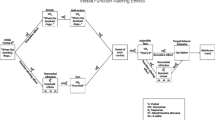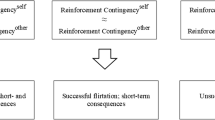Abstract
Attitudes and beliefs are analyzed as verbal behavior. It is argued that shaping by a verbal community is an essential part of the formation and maintenance of both attitudes and beliefs, and it is suggested that verbal communities mediate the important shift in control from events in the environment (attitudes and beliefs as tacts) to control by other words (attitudes and beliefs as intraverbals). It appears that both attitudes and beliefs are constantly being socially negotiated through autoclitic functions. That is, verbal communities reinforce (a) reporting general rather than specific attitudes and beliefs, (b) presentation of intraverbals as if they were tacts, and (c) presentation of beliefs as if they were attitudes. Consistency among and between attitudes, beliefs, and behavior is also contingent upon the reinforcing practices of verbal communities. Thus, attitudes and beliefs can be studied as social behavior rather than as private, cognitive processes.
Similar content being viewed by others
References
Abelson, R. P., & Prentice, D. A. (1989). Beliefs as possessions: A functional perspective. In A. R. Pratkanis, S. J. Breckler, & A. G. Greenwald (Eds.), Attitude structure and function (pp. 361–381). Hillsdale, NJ: Erlbaum.
Ajzen, I., & Fishbein, M. (1980). Understanding attitudes and predicting social behavior. Englewood Cliffs, NJ: Prentice-Hall.
Ajzen, I., & Madden, T. J. (1986). Prediction of goal-directed behavior: Attitudes, intentions, and perceived behavioral control. Journal of Experimental Social Psychology, 22, 453–474.
Baumeister, R. F. (1982). A self-presentational view of social phenomena. Psychological Bulletin, 91, 3–26.
Beattie, J. H. M. (1970). On understanding ritual. In B. R. Wilson (Ed.), Rationality (pp. 240–268). Oxford: Basil Blackwell.
Bem, D. J. (1965). An experimental analysis of self-persuasion. Journal of Experimental Social Psychology, 1, 199–218.
Cialdini, R. B. (1987). Compliance principles of compliance professionals: Psychologists of necessity. In M. P. Zanna, J. M. Olson, & C. P. Herman (Eds.), Social influence: The Ontario symposium (Vol. 5, pp. 165–184). Hillsdale, NJ: Erlbaum.
Crocker, J., Fiske, S. T., & Taylor, S. E. (1984). Schematic bases of belief change. In R. J. Eiser (Ed.), Attitudinal judgment (pp. 197–226). New York: Springer-Verlag.
Eiser, J. R., & van der Pligt, J. (1984). Attitudes in a social context. In H. Tajfel (Ed.), The social dimension: European developments in social psychology (Vol. 2, pp. 363–378). Cambridge: Cambridge University Press.
Erickson, B. H. (1982). Networks, ideologies, and belief systems. In P. V. Marsden & N. Lin (Eds.), Social structure and network analysis (pp. 159–172). London: Sage.
Fazio, R. H., & Zanna, M. P. (1981). Direct experience and attitude-behavior consistency. In L. Berkowitz (Ed.), Advances in experimental social psychology (Vol. 14, pp. 161–202). New York: Academic Press.
Fishbein, M., & Ajzen, I. (1975). Belief, attitude, intention, and behavior: An introduction to theory and research. Reading, MA: Addison-Wesley.
Fleming, D. (1967). Attitude: The history of a concept. Perspectives in American History, 1, 285–365.
Fraley, L. E. (1984). Belief, its inconsistency, and the implications for the teaching faculty. The Behavior Analyst, 7, 17–28.
Guerin, B. (1992a). Behavior analysis and the social construction of knowledge. American Psychologist, 47, 1423–1432.
Guerin, B. (1992b). Social behavior as discriminative stimulus and consequence in social anthropology. The Behavior Analyst, 15, 31–41.
Herek, G. M. (1986). The instrumentality of attitudes: Towards a neofunctional theory. Journal of Social Issues, 42, 99–114.
Herek, G. M. (1987). Can functions be measured? A new perspective on the functional approach to attitudes. Social Psychological Quarterly, 50, 285–303.
Kashima, Y., Gallois, C., & McCamish, M. (1993). The theory of reasoned action and cooperative behaviour: It takes two to use a condom. British Journal of Social Psychology, 32, 227–239.
Katz, D. (1960). The functional approach to the study of attitudes. Public Opinion Quarterly, 24, 163–204.
Kiecolt, K. J. (1988). Recent developments in attitudes and social structure. Annual Review of Sociology, 14, 381–403.
McGuire, W. J. (1985). Attitudes and attitude change. In G. Lindzey & E. Aronson (Eds.), Handbook of social psychology (Vol. 2, pp. 233–346). New York: Random House.
Murray, D. C. (1971). Talk, silence, and anxiety. Psychological Bulletin, 75, 244–260.
Pratkanis, A. R., Breckler, S. J., & Greenwald, A. G. (Eds.). (1989). Attitude structure and function. Hillsdale, NJ: Erlbaum.
Riegler, H. C., & Baer, D. M. (1989). A developmental analysis of rule-following. In H. W. Reese (Ed.), Advances in child development and behavior (Vol. 21, pp. 191–219). New York: Academic Press.
Sahlins, M. D. (1965). On the sociology of primitive exchange. In M. Banton (Ed.), The relevance of models for social anthropology (pp. 139–236). London: Tavistock.
Sherman, S. J. (1987). Cognitive processes in the formation, change and expression of attitudes. In M. P. Zanna, J. M. Olson, & C. P. Herman (Eds.), Social influence: The Ontario symposium (Vol. 5, pp. 75–106). Hillsdale, NJ: Erlbaum.
Silver, B. D., Abramson, P. R., & Anderson, B. A. (1986). The presence of others and overreporting of voting in American national elections. Public Opinion Quarterly, 50, 228–239.
Skinner, B. F. (1957). Verbal behavior. Englewood Cliffs, NJ: Prentice-Hall.
Smith, M. B., Bruner, J. S., & White, R. W. (1956). Opinions and personality. New York: Wiley.
Snyder, M., & DeBono, K. G. (1987). A functional approach to attitudes and persuasion. In M. P. Zanna, J. M. Olson, & C. P. Herman (Eds.), Social influence: The Ontario symposium (Vol. 5, pp. 107–125). Hillsdale, NJ: Erlbaum.
Tedeschi, J. T. (Ed.). (1981). Impression management theory and social psychological research. New York: Academic Press.
Thomas, W. I., & Znaniecki, F. (1918). The Polish peasant in Europe and America. Chicago: University of Chicago Press.
Verplank, W. S. (1955). The control of the content of conversation: Reinforcement of statements of opinion. Journal of Abnormal and Social Psychology, 51, 668–676.
Whitman, W. (1986). Leaves of grass. New York: Viking Penguin, (original work published 1855)
Author information
Authors and Affiliations
Rights and permissions
About this article
Cite this article
Guerin, B. Attitudes and Beliefs As Verbal Behavior. BEHAV ANALYST 17, 155–163 (1994). https://doi.org/10.1007/BF03392661
Published:
Issue Date:
DOI: https://doi.org/10.1007/BF03392661




